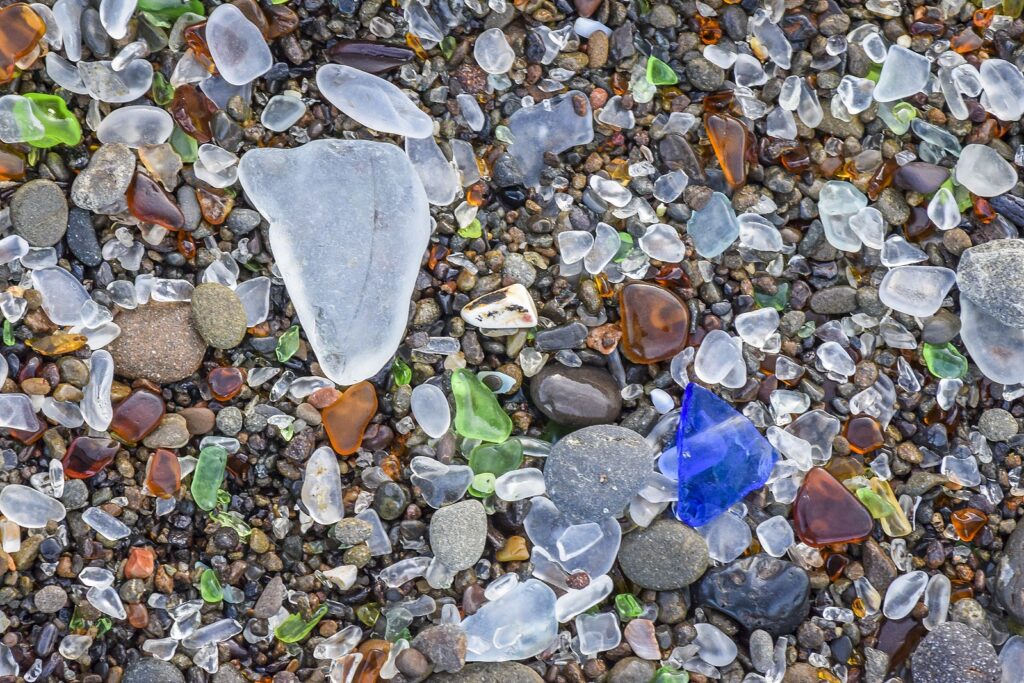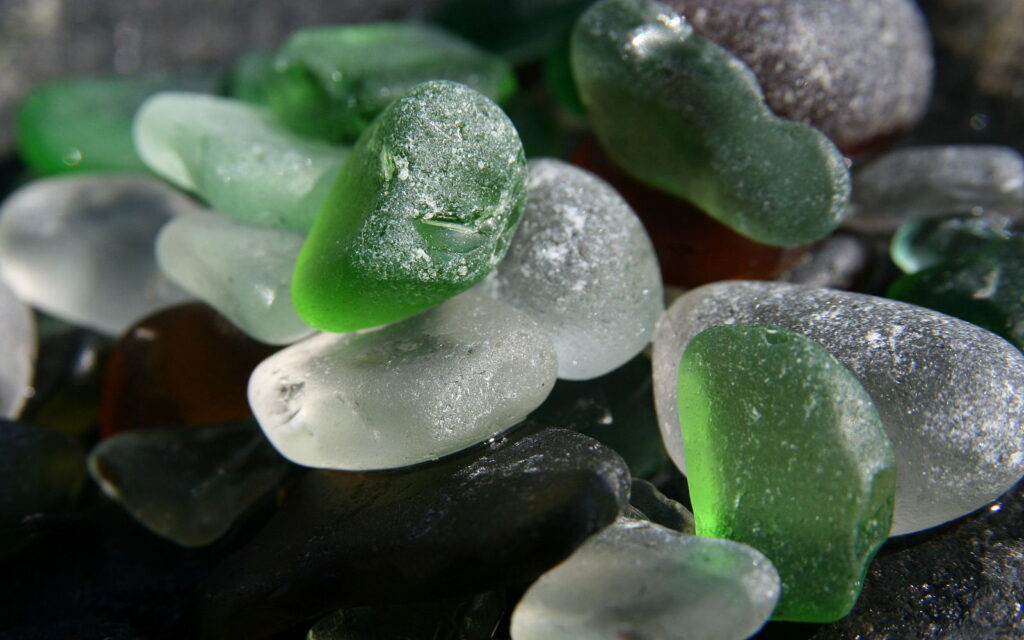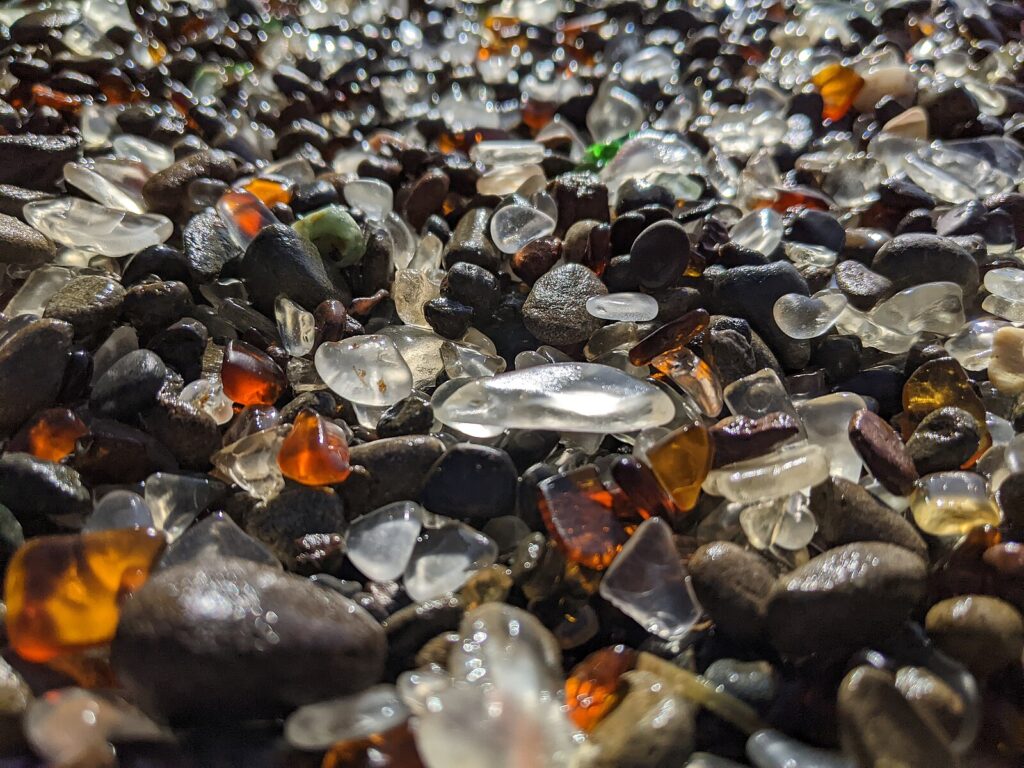Searching for treasures on the beach is one of the main reasons to visit the coastline. People spend hours walking along the shore looking for lost jewelry or sea shells.
One of the most rewarding discoveries is sea glass, a glass shard that has washed up on the shore after being rubbed smooth by the ocean’s waves and rocks.
This glass can be found in a rainbow of colors, and they are easily collected. There are even people who search for sea glass as a hobby, collecting it to admire its beauty or make jewelry.
But what exactly is sea glass, where does it come from, and how do you find it? Read on to find out more!

What is so Special About Sea Glass?
Sea glass isn’t just glass that can be found on the beach. It takes a monumental amount of time to turn from a simple glass chip to sea glass, on average 20-400 years, and sometimes over 100!
It is a unique kind of glass that has been transformed into something beautiful by the forces of nature. From years and years of being tumbled in the ocean, becoming smooth and frosted by the salt within the water.
There are no constraints to the colors that sea glass can come in, either. It can look almost iridescent, changing color depending on the angle it’s viewed.
Some pieces will be pitted, while others as smooth as silk. The never-ending uniqueness is a huge reason why sea glass is so special to so many collectors.
What is Sea Glass? A Detailed Look
Sea glass is a type of broken glass that has washed up on the ocean shores. This can occur due to a shipwreck or even because people have thrown their glass bottles and jars out into the sea.
It is then tossed about by the waves and sea life until it eventually gets smoothed out and jewel-like. It is commonly found in a rainbow of colors.
This sea glass comes from all kinds of objects, with beverage bottles being the most common. More opaque sea glass originates from plates and ceramics.
However, some pieces have been found that were once part of drinking glasses, light bulbs, fishing floats, and even parts of ships! Two things work together to change sea glass from just a sharp piece of glass into something stunning and collectible–salt and waves.
We’ve already talked about the big part that waves play in smoothing out the sea glass, but it’s the salt that gives it the unique, frosted look that sets it apart from other beach treasures.
What Color is Sea Glass?
There are many different colors that sea glass can be, but did you know that some are much rarer than others?
The easiest-to-find colors of sea glass directly correlate to the most common items that may have been lost at sea. Before many environmental regulations went into place, dumping glass in and around the ocean was quite common.
It was this dumped glass that would eventually be swept away and transformed into sea glass. Here are some colors of sea glass, ranked from most common to least common:

- Green, white, and clear–The most numerous colors of sea glass come from the most common types of drinking bottles–beer and soda. After that, clear sea glass originates from broken windows, plates, and other clear glass objects.
- Jade, amber, lime green, light blue– These colors come from bottles of spirits, medicine bottles, whiskey bottles, ink bottles, and jam jars. A variation that is a little harder to find is a certain soft green sea glass, which can only come from Coca-Cola, Dr. Pepper, and RC bottles.
- Purple, citron, opaque white, cobalt blue, and cornflower blue– Opaque white sea glass comes from old white milk bottles. Other colors at this level may originate from Milk of Magnesia bottles, Ball Mason jars, and Vicks VapoRub.
- Pink, gray, teal, black, yellow, and red- The rarest colors come from glass items such as car tail lights, wine bottles, Depression-era plates, Vaseline bottles, and nautical glass.
Which Beach Has the Most Sea Glass?
Sea glass can be found on virtually any beach. That being said, some beaches are more well known for an abundance of sea glass compared to others.
One of the most popular of the beaches is Fort Bragg, California, which at one time had been used as a dumping area for glass. Other interesting, sea-glass-filled locations are Kauai Island and other lava rock beaches in Hawaii, where the sea glass can be found stuck between the rocks.
Is There a Difference Between Sea Glass and Beach Glass?
There actually is! Sea glass can only be made in one place–the sea. On the other hand, ocean glass can be found on freshwater beaches. Like sea glass, it is the result of years upon years in the freshwater lake or river, but the lack of salt and waves causes its creation to take longer.
Sea glass gains a lot of its frosted appearance from the salinity of the ocean, but freshwater, by definition, is salt-less. Because of this, beach glass is often less frosty than its ocean-going counterpart.
Beach glass is still a highly valued treasure, though. Some of the best places to find beach glass are along the shoreline of Mackinac Island, Lake Huron, and the Great Lakes.
Like with sea glass, bodies of water near old dump sites are prime places to search for beach glass.

Is Collecting Sea Glass Illegal?
Here’s something that not a lot of sea-glass lovers want to hear–sea glass is actually trash. But this isn’t meant as an insult, it’s true! All sea glass starts its life as discarded litter, and it’s over years in the ocean that it becomes a beautiful treasure.
So, since sea glass is ultimately antique trash, it’s totally legal to collect. The only stipulation is that you can’t search for sea glass on private beaches. Other than that, go nuts!
References
“All About Sea Glass” https://oceanislebeach.com/all-about-sea-glass/
“Sea glass, a treasure formed from trash, is on the decline as single-use plastic takes over”-Olga Pankova